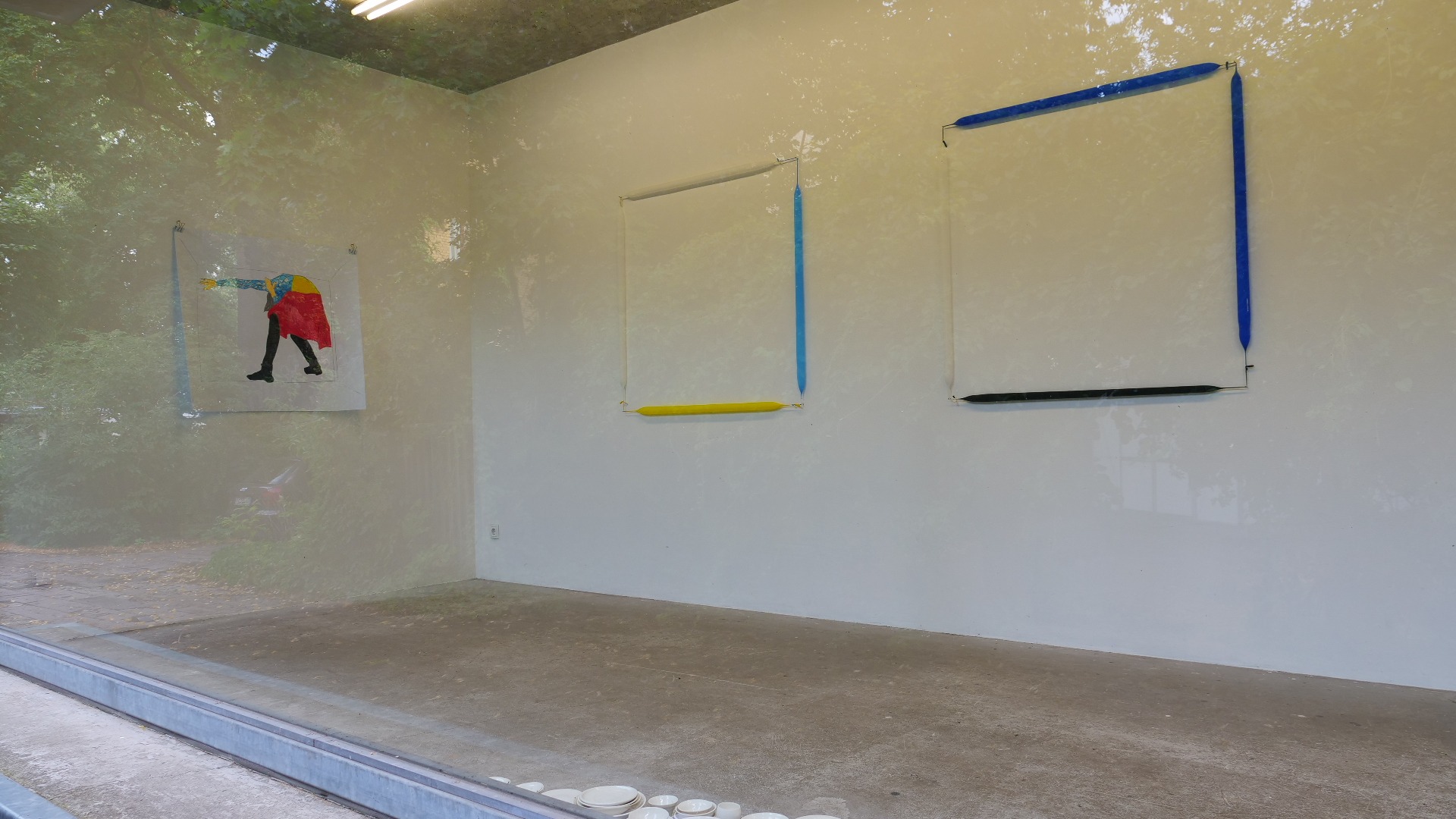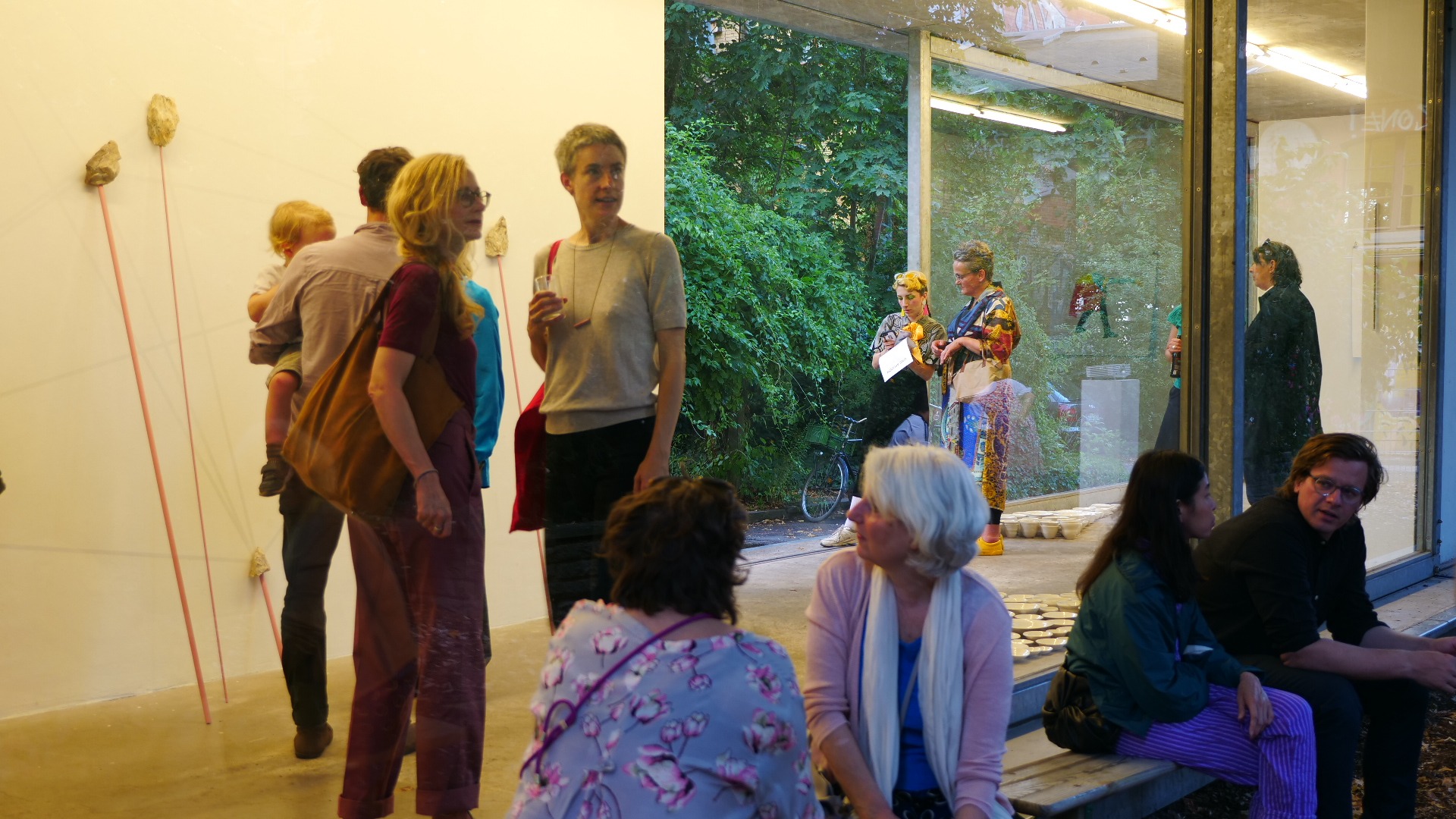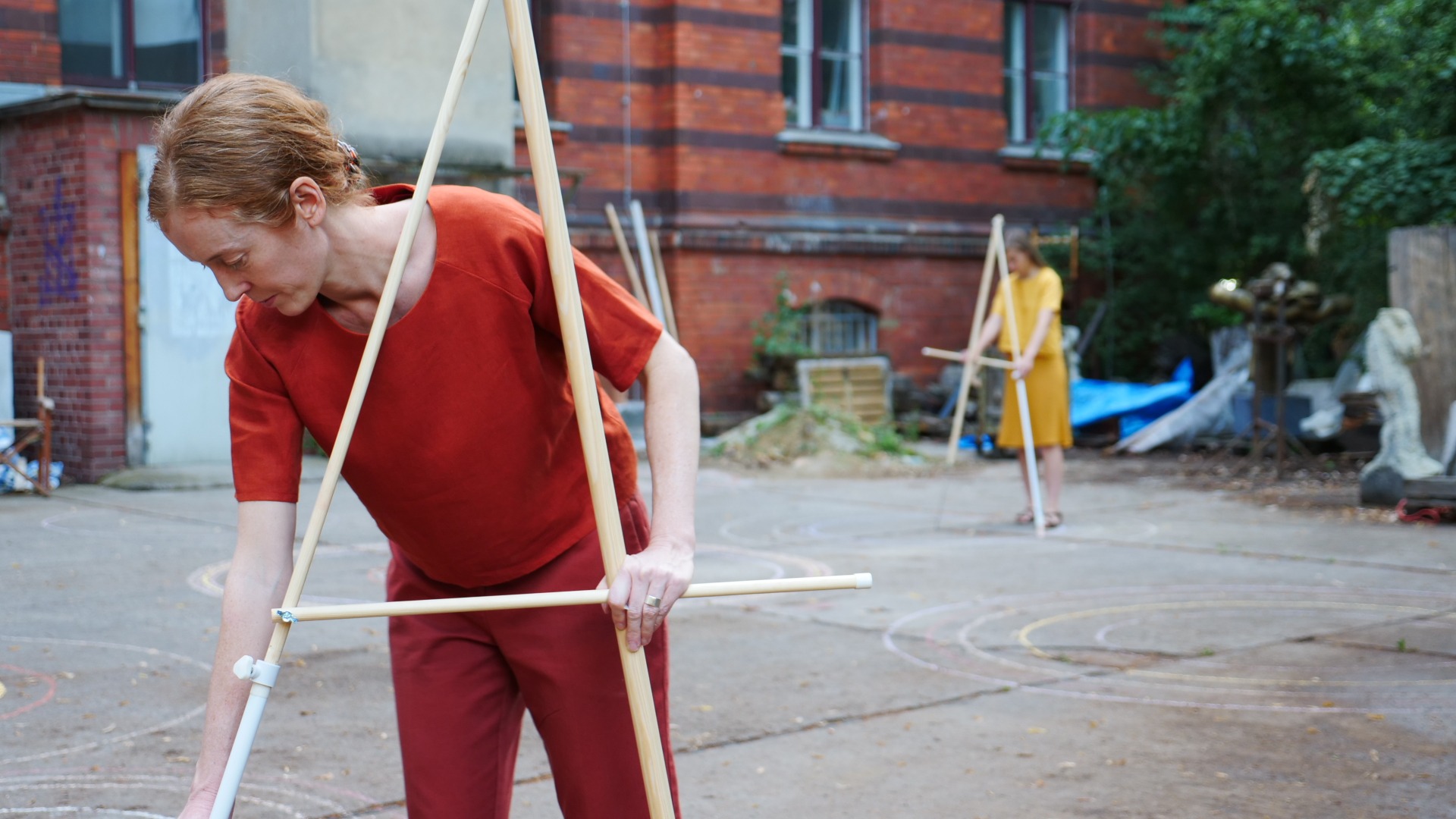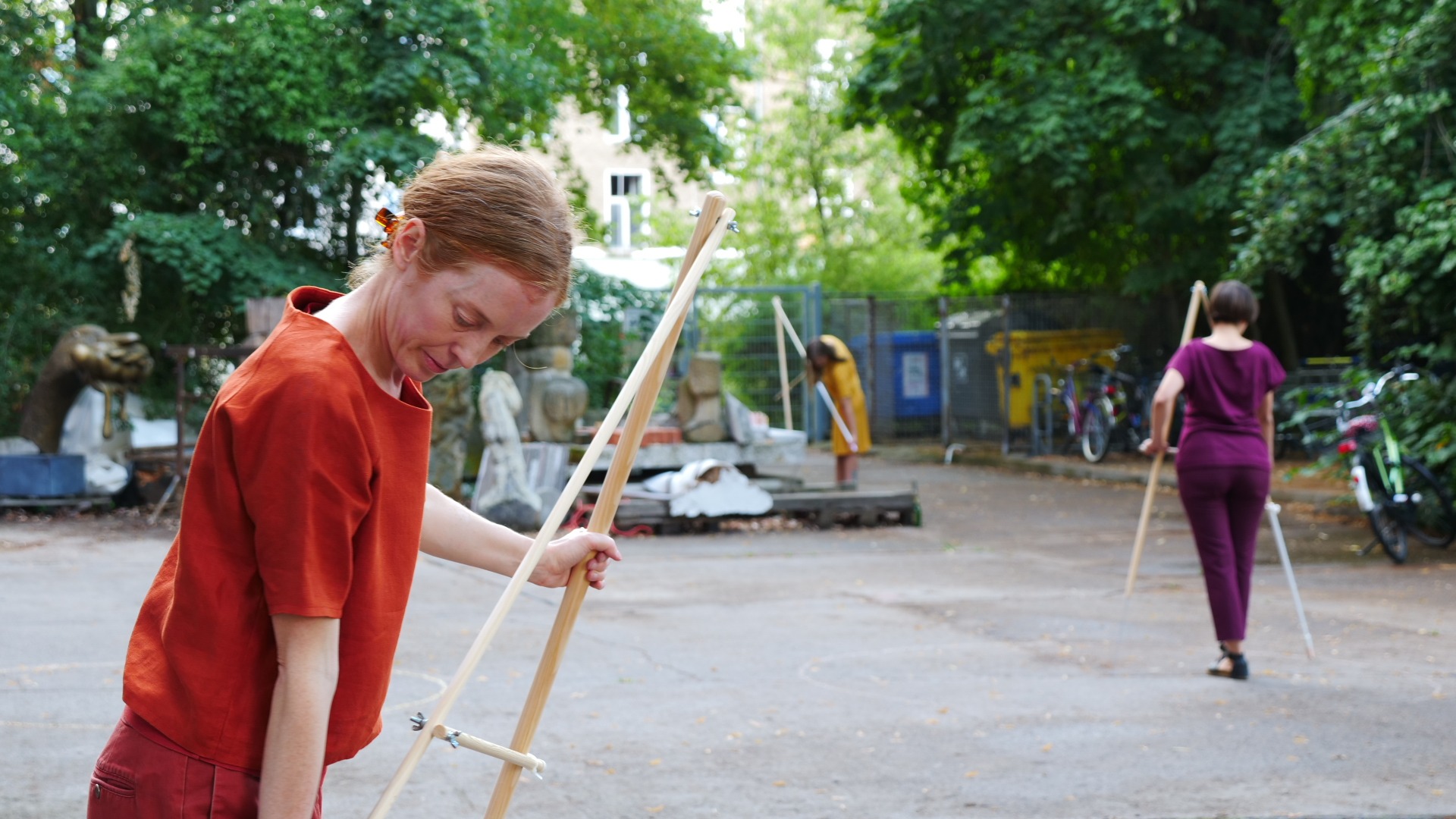APPROPRIATING SPACE (RAUMANEIGNUNG)
Catalog text in Englisch and exhibition views

Exhibition views by Kun Liang




The exhibition Raumaneignung (Appropriating Space) assembles works that deal with the adaptation of our bodies to space, the body’s response to different spaces, and the occupation of these spaces. Depending on the individual focus of each work, the exhibition oscillates from a concrete portrait to abstract Euclidian geometry, our three-dimensional space of conception and the cosmos.
Raumaneignung combines a classical exhibition with a performance in urban space, which is why the project is shown in the exhibition pavilion of the Milchhof artists’ association. The pavilion’s vitrine-like architecture perfectly combines the inside with the outside and also allows the exhibition to be seen outside opening hours and events. Furthermore, Pavillon am Milchhof provides an example of the fabulous places that artists appropriate or create themselves – the project spaces of Berlin, a sensitive, fragile commodity in times of global real estate speculation.
Melanie Irwin and two other performers playfully but meticulously occupy Milchhof’s driveway and parking area, drawing circles on the ground with oversized compasses, inscribing their body movements onto the concrete. Action with Compass and Coordinates combines Irwin’s interests in the relationship between bodies and objects, bodies and movement, movement and lines.
As opposed to common appropriations of public space (e.g. graffiti), this intervention is ephemeral and discreet, as the performance is limited in time, and the performers draw with chalk. The artist reduces her ground drawing to the geometric form of the circle. Her vibrant color palette is embodied by the costumes of the performers, which complement the accumulating chalk drawings with a tri-chromatic moving spatial composition against the urban architectural backdrop. During the performance, several concentric circles materialize, pivoting around the intersections of the square concrete panels. Together with the moving triangles drawn vertically by the wooden compasses, the geometric forms of this performance constitute another triad, which evokes Oskar Schlemmer’s Triadic Ballet (1922).
In a poetic, dance-like manner, the three performers seem to measure the courtyard area, all in Euclidean tradition with makeshift compasses that are animated by the performer’s movements and seem to dance too. Each line has to be negotiated constantly between the protagonists – woman/instrument – and it becomes evident that the corporeal relationship with the instrument, the space, the ground drawing and the geometry forms an important part of the work.
In this sense, Irwin’s performance provides a human, physical way of measuring space, as this measurement has to orientate itself on the dimensions and limits of the human body, being defined and delimited by them. And yet the extreme amplification of the everyday object, the compass (à la Claes Oldenburg), combined with the anachronistic touch of the instrument produce a humorous element so that the performance could also be seen as a metaphor for the absurdity of artistic work (as well as all human activity).
Catherine Evans also takes her own body as a starting point, specifically in her Constellation series, in which a tonally inverted photograph of her back transforms her dark moles into glowing points of light. In an analogy to Euclid’s first postulate from The Elements (300 BC), in which he claims that you should be able to draw a straight line from one point to another, the artist connects the light points in the photograph in every possible way with a ballpoint pen. The resulting network of lines forms an imaginary space, an independent entity based on the artist’s own body coordinates, whereby this irregular geometric body (reminiscent of the polyhedron in Albrecht Dürer’s Melencolia I, 1514), holds an equally mysterious agency.(1)
In her installation work, Standing Stone, Evans transfers her personal constellation into the exhibition space, taping an expansive net of glossy sticky tape across the gallery walls that corresponds directly to the lines drawn on the photograph. Evans marks the respective light-point coordinates with stones, each supported with an oblique rose-colored metal pole.(2) In the first version of this piece, shown in Australia, Evans used volcanic basalt stones from near the Aboriginal stone arrangement Wurdi Youang to draw a bridge to ancient Australian tradition and science. For the Berlin variant, she uses local quartz stone. In this way, the Australian artist, who has lived in Berlin for the last few years, might appropriate her newly adopted home.
In Bill Berger’s Portrait series we also find traces of bodies – in an even more abstracted way. For his large-scale photographs, the US-American artist takes dust as a material, the smallest particles, invisible unless hidden on the negative and thus accidentally amplified in a photograph. Accidental mishaps, interpreted as welcome observations of the everyday, often lead Berger towards new series. Thus, he creates enigmatic abstract portraits of friends, who have provided him with worn clothes to shake off. Visually recalling outer space, the works combine the microcosmos with the macrocosmos, just like Evans’s Constellation.
But Berger doesn’t stop at infinity. He instead titles a video work, in which he filmed the color shifts in the sky during sunset, with the grandiose title ...and beyond the infinite. In fact, the title refers to the very psychedelic third section of Stanley Kubrick’s 2001: A Space Odyssey (1968), “Jupiter and Beyond the Infinite.” Berger’s much calmer tribute can be seen as a contemporary variant of Mark Rothko’s color field painting and one that, because of the title, could be loaded with religious meaning. Alternatively, one might grin due to the technical description of the video, which is looped as an infinite loop but mounted forwards and backwards, wherefore Berger plays ping-pong with the fourth dimension. As in many of his other works, he endows us here with an “unintentional metaphysical study of what (he) can best describe as nothingness.”(3)
With Territorial Claim, Uli Aigner doesn’t show much restraint either. She aims to appropriate the whole world by turning clay. In 2014, Aigner initiated the project One Million when she decided to produce and consecutively number one million eating vessels (cups, mugs, plates, bowls, etc.) – always in relation to a certain person, organization, institution or situation. In the sub-project, Territorial Claim, the artist engraves not only the “production number” but also the name of each country in the world. Thus 206 + 1 vessels are formed – in reference to the 193 UN member states, the Vatican, and twelve further non-UN members listed in 2017, plus one vessel for a stateless person. With this project, Aigner “takes globalization personally,”(4) which is also expressed by the “world performances” the artist organizes, in which different nationalities come together and communication is facilitated via a shared meal on porcelain dishes.(5) In this way, the work gains an extended social dimension within a personal transnational and transcultural structure.
While the 207 objects of Territorial Claim have previously been shown in a circular, globe-like arrangement, for Raumaneignung, Aigner creates a geometrical abstraction of the world in the shapes of triangles. This unconventional way of representing or re-organizing the world evokes obsolete concepts of the world as well as utopian parallel worlds in the spirit of the Situationists.
The interaction between human body and space is pointed out in a more direct way in Aigner’s series of drawings on paper, Selbstportrait innen (Self-portraits inside), which shows the artist constrained in spaces sketched with just a few lines in which her body can hardly fit. The artist struggles with herself and her environment, trying to adjust to a given space – or to define it?
In her series Frames, Hester Oerlemans clearly defines sections of wall space framed by four modeling balloons each attached to the next and stretched between four corner screws. With a twinkle in her eye, the artist appropriates an empty space. Presenting itself in a very simple way, this work shows a myriad of references, such as Piet Mondrian’s formal rigor and color palette, and provides a contemporary memento mori. While the balloons strike a humorous, life-celebrating note, no other material embodies transience so effectively. Even as one appreciates its full shine, one already anticipates the matte wrinkles.
Oerlemans’s “frames” are visually attractive and yet “present” nothing but empty space; thus, the work can be understood as a critique of our society of the spectacle as Guy Debord named it, a society that is still admiring the emperor’s new clothes. Oerlemans creates a stage for absurdity; she claims a place for art and simultaneously questions its significance.
Oerlemans’s work All that I’ve Heard 2016-2017 is based on an appropriation of space that extends the three-dimensional Euclidian space to the acoustic level. Being hearing-impaired since her childhood, the artist collected the batteries of her hearing aid for one year, and assembled the 178 round reflective metal objects – witnesses of uncountable conversations and flows of information – in a Plexiglas tube. What others take for granted, Oerlemans has to attain through technology, and thus the work indirectly deals with the difficulty or incapacity of some to appropriate space.
“I’m drawing a space around myself as a habitat, as a place for connecting with my individual identity, and a productive space for my work/creativity,” says Melanie Irwin about her performance Action with Compass and Coordinates.(6) Such poetic tone combined with humorous notes traverses the entire exhibition of Raumaneignung, even though in everyday life the artists don’t necessarily have enough space or even suffer from lack of space (studio/apartment/exhibition space). Irwin’s creative way of appropriating space – playful and always body-related – could provide a more human alternative to the dominant drawing-board architecture and city planning, as it would leave open spaces that could be constantly re-defined in order to initiate new discourses and to allow mental and corporeal flexibility.
The Milchhof artist association pavilion is an excellent example of how a group of artists can concretely appropriate space by building their own exhibition space.(7) With its transparency it seems to be ephemeral and doesn’t take itself too seriously – if one compares its modest size to the surrounding buildings. But the Pavillon am Milchhof and the adjacent studio building are as important to the neighborhood as the last remaining parks and green spaces. It’s too bad that Milchhof’s former neighbor and project space, General Public, was redeveloped to death a few years ago; and in 2017 the artist bar Babette was pushed out of its wonderful glass pavilion in Karl-Marx-Allee by developer Nicolas Berggruen (to name just two examples). Furthermore, according to the city magazine, tip, 350 affordable artist studios are lost each year due to rising rents.(8) The Senate of Berlin should intervene if it wants to preserve Berlin’s reputation as a city for creatives as well as the interrelated quality of life of its citizens. As for being creative, Virginia Woolf stated this clearly 90 years ago: artists need a room of their own, a refuge that provides mental freedom.(9)
(1) The term agency refers to Bruno Latour’s actor-network theory, in which he states that objects also have a certain kind of active power, see: Bruno Latour: Eine neue Soziologie für eine neue Gesellschaft, Suhrkamp, Frankfurt am Main, 2010.
(2) The rose color in Evans’s work refers to the final tone that results (after several color shifts) from the effect of ambient light on unfixed color photographic paper.
(3) Bill Berger in his application for the PICTURE BERLIN program in 2013.
(4) Uli Aigner in her project description for Territorial Claim, 2017. The location of every vessel of One Million is registered in a digital map of the world, see: www.eine-million.com.
(5) For the 100-year jubilee of the Bauhaus, Uli Aigner organized a “world performance” in January 2019 in the Berlin Academy of the Arts.
(6) Melanie Irwin in an email to the author on 18.03.2019.
(7) The Milchhof association is a studio community founded in 1991 with over 40 artists working in a former school building. Since 2009 they regularly show in their own exhibition pavilion, which is also open to guest projects.)
(8) See Constanze Suhr: “Wer Ateliers vernichtet ...,” tip online from 26.02.2019, www.tip-berlin.de/wer-ateliers-vernichtet/?fbclid=IwAR1hfjFGLdtCqFk0Joty_TQMpcXrHOSVWbZUdO7TX6A3MF3F2YrX8t8UDt0
(9) See Virginia Woolf: A Room of One's Own, Hogarth Press, London, 1929.
